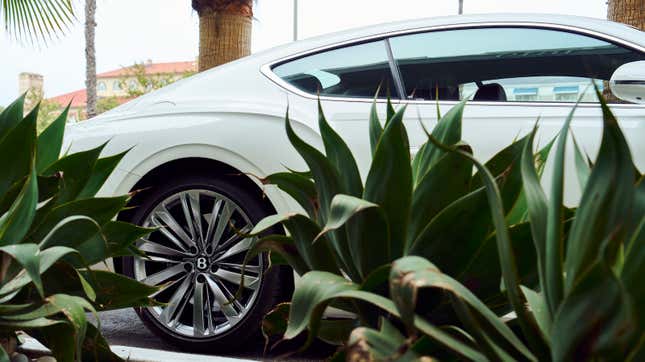
I’ve always been ambivalent about Bentley’s W12 engine. In many ways, it ideally suits the character of the cars that it’s put in, but my heart has always wanted a rev-happy yowling V12 and friends; this ain’t that. My favorite W12 applications have always been ones where it was put in the background of the driving experience – the Flying Spur Mulliner, for example – where its massive wave of torque made it almost feel like you’re driving an EV, especially with that car’s vast array of sound deadening.
The thing is, now that Bentley has confirmed that April 2024 will mark the end of production for the big W12, I am feeling kind of sad about it. Is it a case of regretting the death of one more big, special 12-cylinder engine, or have I unfairly judged the W12 for refusing to be what I wanted it to be and instead just being itself?
To find out, I had to drive some W12-equipped Bentleys, and wouldn’t you know it, the fine folks from Crewe had a day of driving, celebrating its biggest and most powerful engine as it nears the end of its life. During this drive, I was able to sample the Continental GT and GTC, the Flying Spur and the Bentayga – all in Speed trim. So, with fresh driving experience under my belt, have I developed a newfound appreciation of Bentley’s high-powered technological terror? Yes and no.

From a dynamic standpoint, the W12 is still excellent. The torque on offer from its turbocharged 6.0-liters of displacement is buttery smooth and as effortless as I remember. A W12 Bentley feels like it’s playing with large, primal forces to move you forward through space and time. It never feels like it’s just “accelerating.” It never fully disappears into the background like the V12 in a Rolls-Royce, but it’s not as aggressive or lively-feeling as the V8 models, which suits Bentley’s mantra of “Effortless Performance.”
The sound that the W12 makes is still not my preferred cup of tea. It’s a little tuneless and understated in a car that’s anything but. Think less maniacal yowl and more stately grumble. It’s not bad, and in some models, you hear it a lot more than you do in others, but at least it doesn’t sound like the two VW VR6 engines stuck together that, in some ways, it is. We don’t need Bentleys sounding like Chewbacca with a hangover.
Regarding power output, the W12 has always been pretty good but not necessarily class-leading. Its highest-output trim in the very limited Batur produces 750 hp. Most models now are set at 650 hp, which is decent but hardly excessive when considering the weight of anything with a Bentley badge. The 664 lb-ft of torque is a similar story, but the fact that it’s available essentially off-idle at 1,500 rpm is where this engine’s magic begins to show.

Since the W12's introduction for the 2003 model year in the original Continental GT, the W12 has seen a fair amount of tweaking and tuning. Specifically, it’s gotten a 37 percent uplift in hp, a whopping 54 percent increase in torque, and a 25 percent reduction in emissions. It got its first comprehensive rework in 2014 and has been soldiering on since. Also commendable is the W12's unique packaging. Given that the engine is essentially two VR6s mated together, it’s an extremely short engine, especially compared to a traditional V12. Because of that, it’s considerably wider, of course, which makes for other problems, particularly in the case of the poor bastards being tasked with working on them. Still, as an engineering exercise, the W12 remains seriously impressive and truly one of the great leftovers of the legendary Piech era of the VW Group.
To send the W12 out in style, Bentley has planned a number of special edition models which feature the elephantine motor, many of which have already sold out before entering production. The Speed Edition 12, for example, will get 480 examples worldwide – 120 for each model – while a Le Mans tribute model is totally sold out, likewise is the Batur.
After a day behind the wheel of a bevy of beautiful Bentleys, my feelings on the W12's dynamics are the same: It pulls like a train and makes the driving experience of any car equipped with it nearly effortless. Like Bentleys themselves, the W12 feels like a bit of a relic of a bygone era in many ways; idiosyncratic, yes, but there’s charm when you get below that top veneer of class. It’s a perfect fit for the brand, and we should all be sad to see it go. Still, with a future fully battery-electric vehicle coming in 2026, which I suspect will offer similar sensations with even more refinement, there’s still plenty to look forward to from the Flying B.
